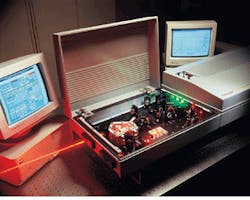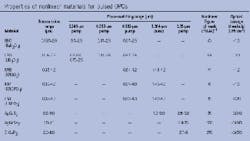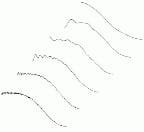Improving high-power OPO performance
MICHAEL B. RADUNSKY
A vast number of nanosecond solid-state tunable devices are currently used by the world`s laser community. With output wavelengths from 200 to 10,000 nm these systems are applied to problems as varied as remote sensing of pollutants and the study of human aging. Parametric conversion systems embody the most recent developments in the field, with almost every pulsed-laser manufacturer now offering some type of optical parametric oscillator (OPO).
Parametric converters are both fundamentally and practically different from lasers. In a laser, population inversion must occur such that more gain centers (metal cations or organic dye, for example) are in an excited state than in the ground state. When the active specie goes from this highly excited state to a less energetic state, energy is emitted in the form of light. Stimulated emission from these excited states leads to the gain exhibited by a laser.
Parametric process
In the parametric converter there is no excited state. The electric field in the pump laser wave directly drives electrons in the nonlinear medium. The accelerated electrons then generate their own oscillating electric field. In a linear medium this field propagates in the same direction, with the same phase and frequency, as the incident wave. In a nonlinear medium, though, the response of the electrons is not limited to the same frequency as the driving field. Other frequencies are also generated, which is the genesis of the tunable parametric converter.1
The nonlinear response inherent in a parametric converter places design constraints on parametric devices that are not present in a linear medium. Hence, pump-laser characteristics, polarization, and directional effects, for example, must be carefully scrutinized when designing an OPO. Other factors include a smaller nonlinear drive than the gain in lasers and thresholds for parametric generation that are typically tens of megawatts per square centimeter, which precludes flashlamp pumping the device.Various nonlinear materials are used in OPOs (see table).2 The nonlinear response of the OPO crystal converts the pump laser light to two new frequencies, the signal and idler, where energy is conserved, hence:
npump = nsignal + nidler
Adjustment of the crystal temperature, pump-laser wavelength, or—more commonly—the phase angle between the oscillator axis and the crystal axis, allows the wavelengths of the signal and idler outputs to tune smoothly.
A single pass through a crystal with a typical Nd:YAG-laser pulse (~5 ns, 100 mJ, 355 nm) will, in fact, produce very little gain in the parametric waves. Acceptable energy levels are obtained using resonators and amplifiers. In this case, the signal and/or idler waves build up in the parametric oscillator in a fashion similar to a laser resonator and produce conversion efficiencies approaching 50%.
Pumping the oscillator
As the first stage of an OPO, the pump laser dramatically affects the performance of the overall system—much more so than with other tunable devices. The spatial profile, bandwidth, pointing stability, divergence, and pulse length of the pump laser all play important roles. A smooth spatial profile is essential because "hot spots" in the beam can damage the nonlinear crystal. For narrow-band or single-mode devices, a highly modulated pump profile can cause mode competition as each intensity maximum tries to establish its own mode. The result is an unstable and spectrally broadened output.
Current Nd:YAG lasers offer two types of beam profiles: either an approximation to a Gaussian or an approximation to a flat top. Our experience has been that either profile at the crystal is adequate for pumping OPOs—emphasis on the profile at the crystal is key. Whereas a Gaussian beam undergoes no dramatic changes in its intensity profile as it propagates, the flat-top profile evolves and this evolution must be managed (see Fig. 1).The bandwidth of the pump-laser beam is reflected in the bandwidth of the signal and idler outputs (energy conservation). Thus, most narrowband OPOs employ injection-seeded pump sources.
The output wavelengths are a function of the angle made between the pump wave vector and the optical axis. If the pointing stability of the pump laser is poor, then this angle changes on a shot-to-shot basis and, hence, so does the output wavelength. Pointing stability on the order of 100 µrad (FWHM) is needed to keep the wavelength fluctuations within acceptable levels.
A "build-up-time" is associated with an OPO. During this time the pump pulse is in the cavity but only negligible amounts of signal or idler have built up in the generator. The parametric process is instantaneous because of the coherent nature of the effect. When the pump pulse ends, therefore, there is no more gain. Thus parametric output pulses are always shorter than the pump-laser pulse; the degree of shortening depends on the cavity design and the peak power of the pulse, but in commercial narrow-band systems it is about 2-3 ns. Pump-laser pulses of about 4-7 ns are, therefore, appropriate. Shorter pulses must compensate by having higher power densities, which may damage the crystals.
Resonators
An OPO can be singly resonant on either the signal or the idler wave or doubly resonant on both. Commercial devices are usually singly resonant because of fewer design constraints, including, for example, the bandwidth of the coated cavity optics and mode matching of the oscillator to the two resonated waves.
Side pumping of an OPO is not possible, though choices can be made as to pump geometry. Early systems were pumped through one of the cavity end optics with a coaxial geometry. Variations on this geometry bring the pump beam into the cavity off the surface of a dichroic and may have noncollinear pumping. The former relieves tolerances on the optical surfaces of the cavity. Noncollinear pumping can improve the bandwidth of a restricted cavity due to narrowing of the acceptance angle of the crystal in this pumping geometry (see photo at top of this page).3 In addition, pumping off-axis allows for retroreflection of the pump laser without setting up a secondary cavity. Double pumping in this manner reduces the oscillation threshold and therefore the risk of burning the cavity optics.
The oscillator can be configured with or without bandwidth-restricting elements in the cavity. A "free running" OPO contains no bandwidth restriction so the spectral content of the output is determined by the bandwidth acceptance of the nonlinear crystal. The type of interaction, the crystal identity, and pump-laser bandwidth and pulse duration become limiting factors. Typically, Type I interactions have a larger acceptance bandwidth and therefore broader spectral output than Type II interactions. The gain in the latter, however, is lower. Longer and spectrally narrower pump pulses also result in narrower outputs. The increased number of round trips made by the resonated wave with a longer pump pulse allows for better mode definition and hence a narrower output. Bandwidths from 10 to 300 cm-1 are common for this type of device.
To obtain the single-mode performance of our Mirage series of OPOs—based on KTP and BBO—we have combined the reduced bandwidth acceptance of a Type II interaction, a grazing incidence grating configuration, and active cavity stabilization. Between these extremes is another class of optical parametric oscillators with bandwidths of about 0.2-0.3 cm-1, achieved with high-gain Type I interactions in a relatively simple device employing only a grazing incidence grating. The relatively low gain of an OPO means that prism beam expanders are not often used, in contrast to many dye laser oscillators. Further reduction of the bandwidth can be achieved by properly aligning the grating with respect to the optic axis of the nonlinear crystal. Rotation of the polarization of the resonated wave with a waveplate so that the grating and the optic axis are in the same plane can reduce the output bandwidth by a factor of two or more.
Amplifiers
Bandwidth-restricted OPOs tend to be relatively low in gain; therefore parametric amplifiers based on the same principles as the oscillator can be used to increase the total conversion of the pump wave into tunable radiation. Seeded amplifiers will take on a convolution of the bandwidth characteristics of the seed and the pump. This two-stage approach then yields the desirable combination of narrow bandwidth and high energies (up to about 100 mJ).
Current parametric amplifier technology divides itself into two categories, nonresonant and resonant. A nonresonant or linear amplifier is a single-pass device. Seed and pump pulses are combined in the crystal(s), and parametric down-conversion of the pump occurs. Only one parametric wave—either the signal or the idler—need be present at the input; the other will be generated to match the gain of the seed. A resonant amplifier takes advantage of multiple passes of the pump and parametric waves through the crystal to maximize gain. In addition, the resonant quality of the amplifier can help define the mode, thereby improving beam quality.
Both types of amplifiers have advantages. A resonant amplifier is most effective for very small seed energies because it maximizes gain. Hence, microjoule-level seeds can make the most of a resonant amplifier. On the downside, though, back conversion of the signal and idler waves into the pump can occur because the circulating power can be quite high. The high-intensity (central) portion of the parametric waves in the cavity may consequently suffer and degrade the beam quality, negating the above-mentioned mode improvement.4 In addition, a resonant amplifier has its own mode structure, which should be made to actively match that of the master oscillator if the system is to be scanned with optimum performance. This adds complexity to the system as a whole.
The linear amplifier has lower gain than a resonant device but does not suffer from back conversion. The overall gain, though, can be improved to nearly equal that of a resonant amplifier, without back conversion, by optimizing the crystal length carefully.
Seeding can control the bandwidth and frequency of the output of a parametric amplifier.5 OPOs often serve as seed sources for OPAs, though pulsed dye and Ti:sapphire lasers and tunable CW lasers can also be used.
Applications
The applications for OPOs are as wide ranging as their tunability. One example of how an OPO is used is in the study of human aging at the University of Kentucky Medical Center (Lexington, KY) where the chemical changes that occur in the brain with aging or after a stroke are being evaluated by Dr. Robert Lodder and coworkers.
Near-IR light penetrates the skull and can reveal the degree of brain tissue oxidation—indicated by chemical damage to fats and proteins. Analysis of the near-IR absorption spectrum reveals the amount and types of fats and proteins. "Near-IR spectrophotometry produces images that contain more specific chemical information on lipids and proteins than is available through CAT or MRI imaging," explains Lodder. "The technique is also noninvasive, which enables us to monitor disease directly, within individual subjects. It is superior to traditional methods of analysis, which require removal of tissue samples, comparison between subjects, or other indirect means."
In a subject of increasing age or victim of a stroke, the lipid (fat) signals shift to a longer wavelength, which suggests that unsaturated fatty acids are converted by oxidation to the saturated form. Lodder's team found that these changes, when spurred by a stroke, occur well after the initial blood clot prevents oxygen from reaching the tissue. Analysis of the near-IR scans of gerbils subjected to induced strokes shows damage began at least four hours after circulation was restored. By this time, free radicals had built up in the oxygen-deprived area and were attacking nearby tissues. The normal mammalian metabolism of aging also generates small quantities of free radicals resulting in similar brain tissue damage.
Dr. Lodder and his team are testing the effectiveness of drugs that could treat stroke and other aging-related diseases. Infrared spectrophotometry also detects water and is expected to be used for evaluation of edema in the human brain, a common result of concussion.
New developments
Near term, we expect an increase in the quality of commercial solid-state tunable devices. As manufacturers master the nature of the OPO, mechanical improvements will make it exceedingly rugged and reliable. Longer-term improvements are likely to include better seed sources, more robust crystals with higher nonlinear coefficients and more varied wavelength coverage, and higher-efficiency amplifiers with concomitant higher output energies.
REFERENCES
1. R. L. Byer, "Optical parametric oscillators," in Quantum Electronics: A Treatise IB, H. Rabin and C. L. Tang, eds., Academic Press (New York, NY), 1975.
2. B. J. Orr, M. J. Johnson, and J. G. Haub, "Spectroscopic applications of pulsed tunable optical parametric oscillators," in Tunable Laser Applications, F. J. Duarte, ed., Marcel Dekker (New York, NY), 1995.
3. J. Jacob and B. Harlamoff, Proc. CLEO (1995), paper CThC4.
4. J. Jacob and B. Harlamoff, Continuum, unpublished results.
5. J. E. Bjorkholm, H. G. Danielmeyer, Appl. Phys. Lett. 15, 171 (1969).


